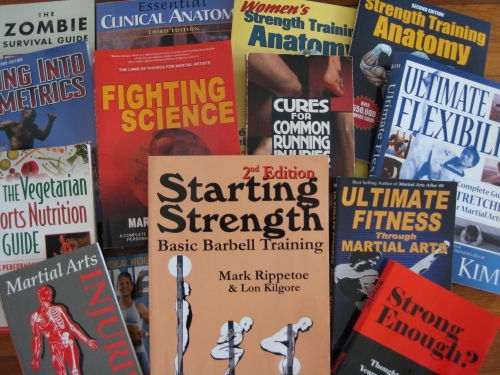
Pavel Tsatsouline’s name is bound to come up in discussions of Russian kettelbell training, climbing, gymnastics and conditioning for martial arts and combat sports. His book on bodyweight strength training “The Naked Warrior” is extremely popular with martial artists, climbers, and the gym-less legions. He has an impressive pedigree upon which to base his work: he was a nationally ranked Soviet Kettlebell competitor, physical trainer for the Soviet Special Forces, and has trained members of the US Army, Marine Corps and Secret Service. After reading countless gushing testimonials in a variety of martial arts and fitness forums, I got a copy of “The Naked Warrior” to see what the buzz is about.
The goal of “Naked Warrior” is simple: to develop maximal strength without the benefit of gym equipment. Pavel (as he is known) explains at the outset that body weight strength training is not superior to standard weight training. He points out that, “You will make your best gains if you have access to quality hardware: barbells, kettlebells, etc.” Simply put, when one has access to a gym, use the gym. But when one does not, it’s preferable to use whatever is available than to go without training. For the broke or on-the-go martial artist, Pavel contends that BW strength development is advantageous only in that it can be done almost anywhere, requiring the purchase of no special equipment- hence the term “Naked Warrior,” a phrase coined by renowned self defense instructor Tony Blauer. If left with absolutely nothing, the competent martial artist ought to be able to take care of him or herself. Otherwise, all available resources for strength development should be used without bias. Strength development is governed by the same principles regardless of approach- neither is magically superior to the other.
I’m not familiar with his other publications, but it would seem that Pavel draws his information from Soviet strength research, various forms of martial arts training, experience in competitive strength training and his background as a physical trainer. The training plan laid out in the book is built on the concept of “Greasing the Groove.” In a nutshell, Greasing the Groove is a matter of incorporating a few exercises into your daily routines, such as stopping to do a few pull-ups on a certain door frame every time you pass by it. Without a set exercise routine (or the time to pursue it) GTG is Pavel’s solution for incrementally building strength in short bursts of training. He explains that after a few weeks of doing numerous small sets throughout the day, overall strength will improve and the maximum number of reps one can perform will increase substantially. Of special interest to karate practitioners is his frequent reference to the Sanchin kata as an example of a suitable exercise for isometric contraction, muscular control and the accompanying posture development. With GTG as a framework, Pavel goes on to describe how to best develop strength with limited time and resources.
For the purposes of this book, Pavel defines strength as a skill, and outlines three types of strength development:
1. Maximal strength
2. Explosive strength
3. Strength endurance
His principles for achieving gains in maximal strength are few:
– Strength is developed with bodyweight by focusing on a limited number of high-resistance, low rep full body exercises (sets of five is his typical suggestion)
-Intense contraction of the muscles over shorter durations is preferable to working a muscle to failure; add more resistance to increase difficulty
-Higher resistance is achieved by ‘deliberately imposing poor leverage and unfavorable weight distribution between the limbs’ while minimizing bounce and momentum
Explosive strength and endurance strength can be gained through variations in exercises or by executing longer sets. He cites related strength skills that should be familiar to karate folks: breath control under tension, application of pressure from the legs upward (the “static stomp”), and contraction of the core muscles to lower and support the shoulders. As an aside, these concepts go hand in hand with many of boxing legend Jack Dempsey’s field-proven guidelines for exploding the body’s weight into knockout punches, but that is a topic for another article.
Pavel prescribes two exercises to use in a GTG program: the one arm pushup and the one legged squat, or pistol. He refers to these two exercises as the “power lifts of bodyweight” in that they involve maximal contraction of the body as a unit to perform correctly. The minimal number of recommended exercises is offset by the wide range of variety offered by manipulating leverage and variations in execution. For example, the pistol can be varied by lowering to the bottom of the motion, rocking backwards onto the butt, rocking forwards onto the foot again, pausing, then powering back up with clean form. Another variation involves holding the free leg bent behind the body and dropping until the bent knee can touch the floor, sort of like a one-legged lunge. Likewise, one arm pushups can be executed as a dand (i.e., “dive bomber” or “”tiger” pushups), with one leg extended, or for the advanced, from a handstand. Combining these variations with other variations offers an escape from boredom as well as strength development that targets different muscle groups and ranges of motion. The basic exercises as well as several variations are shown in clear photographs, as well as some strategies for using blocks or furniture to gradually build up to unassisted execution. For the Iron fiends out there, several photographs depict the pistol combined with kettlebell lifts as an advanced variation to be pursued after establishing basic overall strength and safe technique.
Despite the practicality of Pavel’s recommendations I would like to look at some of the Soviet strength studies that much of this work seems to be based on, but these sources are not provided in the text. Normally this pulls at my attention as I read such work; the information is useful, but how was it arrived at? How was it tested, and by whom? However, after several weeks of conscious effort with the pistol and several variations, I’ve noticed a considerable increase in leg stability and strength. Kicking power, takedowns and control from the bottom guard have improved. Combined with a sensible free weight program or through bodyweight alone, the training methods of “The Naked Warrior” should be useful to martial artists of any stripe for developing strength and control.
Despite the lack of supporting objective data, I would recommend this book to a student who is beginning to get interested in developing strength specifically for karate, or to someone whose schedule just doesn’t allow much time for trips to the gym. I’ve found that incorporating various bodyweight manipulations into training time can address strength development for students who may otherwise never visit the gym. In my experience, BW exercises can also help to illuminate certain physical alignments and abdominal muscular contractions that often get over-mystified in inexact karate terminology. As an exponent of Duct Tape Ryu (if you can’t afford it, make your own), I appreciate the utility of another avenue for nudging students into basic strength development and body awareness without the need for equipment. This book can provide some starting points for incorporating such exercises into one’s training routines.
For overall content and applicability, TKRI gives “The Naked Warrior” 4 out of 5 possible Bruised Knuckles.




















 are available here.
are available here.